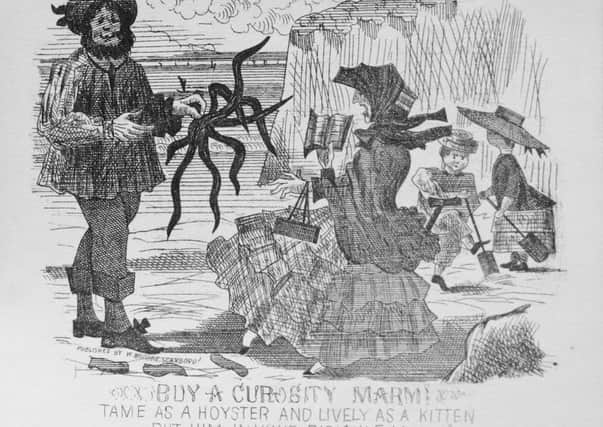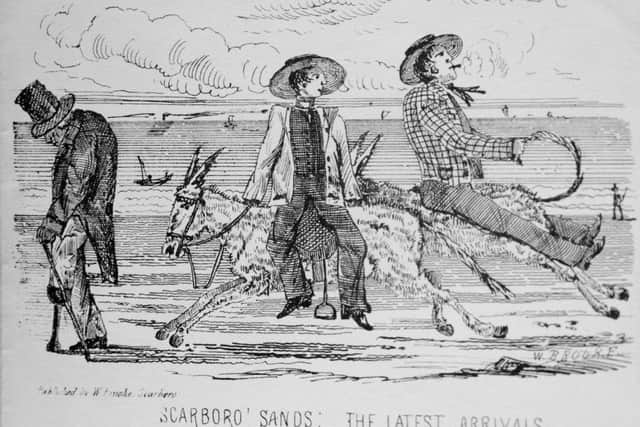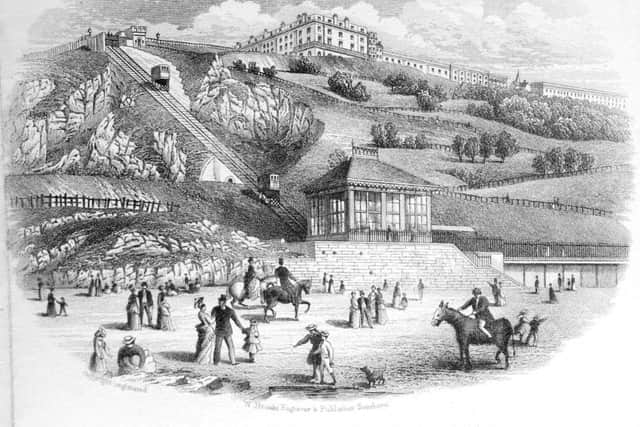Exhibit of the Week: '˜Wish you were here' '“ the Victorian way


This crudely drawn cartoon is one of a set of letterheads, presumably designed for holidaymakers to send home to their loved ones before the days of the picture postcard. The set boasts an interesting mix of the vulgarly comic – another dandy chap falls foul of a crab which nips his finger, with the legend ‘Caught a tartar’ – and the straightforward scenic, all drawn in rather more sophisticated fashion – there are views of the interior of St Martin’s Church, a bustling Valley Gardens, the ‘incline carriage way’ at the Spa, the ‘new Wesleyan Chapel’ on Westborough, and a general view of the South Bay with only part of what appears to be the West Pier under construction (I stand to be corrected on that – the perspective makes it difficult to judge).
The views give us an inkling of the dates the letterheads were printed, which we’d guess to be in the 1870s: St Martin’s was completed in 1863; the Valley Bridge in 1865; what we now know as Westborough Methodist Church in 1862; the South Cliff lift – the UK’s first funicular railway – in 1873; and the West Pier in 1822.
Advertisement
Hide AdAdvertisement
Hide AdAll of them bear the trade name of W Brooke, who is variously described across the set as a Scarborough ‘engraver’, ‘lithographer’ and ‘publisher’.


We’ve been unable to find out anything much about W Brooke, although the company seems to have had a fairly wide range of printed products – as well as the letterheads, they published, sometime in the late 19th century, a book or pamphlet called C E Guldberg’s apparatus for teaching the Blind to write with lead pencil, translated from the German. And a couple of years ago, local auctioneers David Duggleby’s sold a coloured engraving of Scarborough viewed from Oliver’s Mount published by Messrs Petch, architects, and W Brooke, engraver, of Bar Street.
Further information comes from the Bulmer’s Directory of 1890, which lists local tradesmen including ‘Brooke Wm., lithographer, &c., 28 and 30 Bar street; h [home?] 120 Falsgrave Road’.
Of course, by the 20th century, holidaymakers were able to send postcards home to friends and family, the definition of a postcard being a card that can be sent through the mail without an envelope and, typically, with a decorative image on one side.
Advertisement
Hide AdAdvertisement
Hide AdBut did you know that the first picture postcards in this country were printed by another local company – the renowned ETW Dennis & Sons, which sadly closed its doors for the last time in 2000?


In 1894, the Royal Mail gave permission for British publishers to print postcards which could be sent via inland mail using a halfpenny stamp, and Dennis’s was the first company to capitalise on this exciting new novelty.
ETW, by the way, stood for Edward Thomas West. But I recall being told by my mother, who worked at Dennis’s in the 1940s and early 50s, that the company was known affectionately to the girls on the shop floor as ‘Eddy Teddy Willy’s’.
W Brooke’s souvenir letterheads are part of part of the Scarborough Collections, the name given to all the museum objects and artwork acquired by the borough over the years, and now in the care of Scarborough Museums Trust. For further information, please contact Collections Manager Jennifer Dunne on [email protected] or 01723 384510.